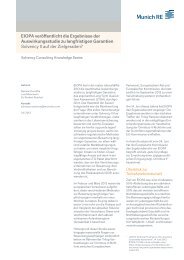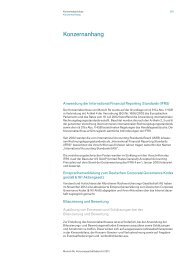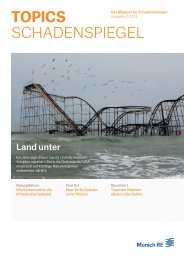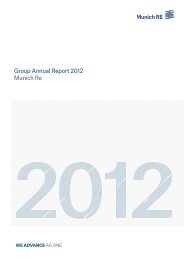Munich Re Group Annual Report 2006 (PDF, 1.8
Munich Re Group Annual Report 2006 (PDF, 1.8
Munich Re Group Annual Report 2006 (PDF, 1.8
Create successful ePaper yourself
Turn your PDF publications into a flip-book with our unique Google optimized e-Paper software.
<strong>Munich</strong> <strong>Re</strong> <strong>Group</strong> <strong>Annual</strong> <strong>Re</strong>port <strong>2006</strong> Notes_Assets<br />
The net investment result comprises regular income, income from<br />
write-ups, gains and losses on the disposal of investments, other<br />
income, write-downs of investments, management expenses, interest<br />
charges and other expenses. <strong>Re</strong>gular income and expenses from<br />
investments measured at fair value without impact on profit or loss<br />
are calculated in accordance with the effective interest method, i.e.<br />
any premiums or discounts are deducted from or added to the acquisition<br />
costs, with impact on profit or loss, until maturity.<br />
Impairment<br />
<strong>Re</strong>gularly, at each balance sheet date, we assess whether there is any<br />
substantial objective evidence of impairment in a financial asset or<br />
group of financial assets.<br />
In the case of all fixed-interest securities held to maturity or available<br />
for sale, as well as all non-fixed-interest securities, impairments<br />
in value – in contrast to temporary diminutions – are recognised as<br />
an expense in the income statement. IAS 39.59 contains a list of factors<br />
providing substantial objective evidence of impairment of such<br />
financial assets. In addition, IAS 39.61 states that for equity investments,<br />
a significant or prolonged decline in the fair value of the<br />
investment below its acquisition cost is objective evidence of impairment.<br />
These rules are given more concrete form by means of<br />
appropriate internal guidelines.<br />
Acquisition cost is determined on the basis of the average company<br />
purchase prices. In the case of an impairment, a write-down is<br />
made to the fair value at the balance sheet date, i.e. generally the<br />
publicly quoted market price. If there is a further fall in the fair value<br />
of equity investments that have already been written down once, a<br />
further write-down recognised in the income statement is made<br />
again immediately, even if the impairment is only temporary. Impairments<br />
recognised in profit or loss may not be reversed through profit<br />
or loss.<br />
In the impairment test for financial assets carried at amortised<br />
cost, we first asses whether objective evidence of impairment exists<br />
for items that are individually significant. If this is not the case, and<br />
also in the case of individually insignificant items, the impairment<br />
test is carried out collectively on the basis of groups of similar financial<br />
assets. Assets that are individually assessed for impairment are<br />
not included in the collective assessment. The amount of the probable<br />
loss is measured as the difference between the carrying amount<br />
of the asset or group of assets and the present value of estimated<br />
future cash flows. The carrying amount is reduced by this amount,<br />
which is recognised as an expense. If, in a subsequent period, the<br />
reasons for the impairment cease to apply, the impairment is<br />
reversed, with impact on the income statement. The resultant carrying<br />
amount may not exceed the original amortised cost.<br />
C Investments for the benefit of life insurance policyholders who<br />
bear the investment risk<br />
These are investments for policyholders under unit-linked life insurances.<br />
They are measured at fair value. Unrealised gains or losses<br />
160<br />
from changes in fair value are included in the investment result.<br />
These are matched by corresponding changes in the technical provisions<br />
(equity and liabilities item D), which are taken into account in<br />
the underwriting result.<br />
D Ceded share of technical provisions<br />
The share of technical provisions for business ceded by us is determined<br />
from the respective technical provisions in accordance with<br />
the terms of the reinsurance agreements, cf. the notes on equity and<br />
liabilities item C. Appropriate allowance is made for credit risk.<br />
E <strong>Re</strong>ceivables<br />
<strong>Re</strong>ceivables on primary insurance business, accounts receivable on<br />
reinsurance and other receivables are accounted for at face value.<br />
Adjustments of value are made if there is objective evidence of<br />
impairment, cf. assets item B (Impairment)<br />
F Cash at bank, cheques and cash in hand<br />
Cash and cheques are accounted for at their face value.<br />
G Deferred acquisition costs<br />
Deferred acquisition costs comprise commissions and other variable<br />
costs directly connected with acquisition or renewal of insurance<br />
contracts.<br />
In life business and health primary insurance, acquisition costs<br />
are capitalised and amortised over the duration of the contracts,<br />
either proportionally to the premium income (FAS 60) or proportionally<br />
to the respective contracts’ expected gross profit margins calculated<br />
for the relevant year of the contract term (FAS 97, 120). The<br />
allocation of individual contracts to the FASs concerned is shown in<br />
the notes on equity and liabilities item C. In determining the amount<br />
of amortisation, we take into account an actuarial interest rate and<br />
changes resulting from the disposal of contracts from the portfolio.<br />
In property-casualty business and health reinsurance, the deferred<br />
acquisition costs are amortised on a straight-line basis over the average<br />
term of the policies, from one to five years. Deferred acquisition<br />
costs are regularly tested for impairment using a liability adequacy<br />
test as per IFRS 4; cf. notes on equity and liabilities item C.<br />
H Deferred tax assets<br />
Under IAS 12, deferred tax assets must be recognised in cases where<br />
asset items have to be valued lower, or liability items higher, in the<br />
consolidated balance sheet than in the tax accounts of the <strong>Group</strong><br />
company concerned and these differences will be eliminated at a<br />
later date with a corresponding effect on taxable income (temporary<br />
differences). Also included are tax assets deriving from tax loss<br />
carry-forwards. We take into account the tax rates of the countries<br />
concerned and the company’s respective tax situation; in some<br />
cases, for purposes of simplification, we use uniform tax rates for<br />
individual circumstances or subsidiaries. Where unrealised losses on

















